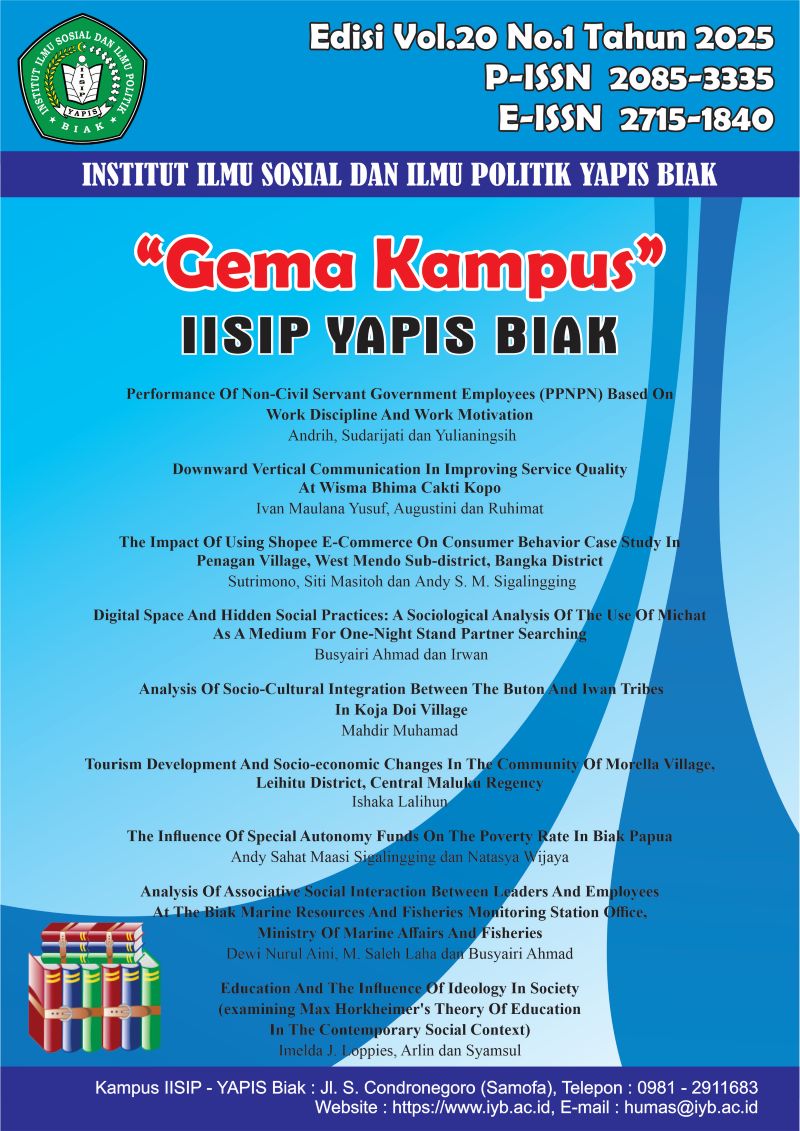DOWNWARD VERTICAL COMMUNICATION IN IMPROVING SERVICE QUALITY AT WISMA BHIMA CAKTI KOPO
Abstract
Abstract
This study aims to analyze the vertical communication between leaders and employees and its impact on the quality of service at Wisma Bhima Cakti Kopo. A qualitative approach is used through in-depth interviews with key informants and supporters. Based on the theory of vertical communication, the results of the study show that downward communication has a more significant influence on employee readiness in carrying out tasks, through work instructions, task explanations, regulatory notices, and work motivation. Meanwhile, upward communication functions as a feedback tool, although its effectiveness is still limited. These two types of communication complement each other and affect service quality indicators, such as reliability, competence, accessibility, communication, and security. To improve the quality of service, improvements are needed in the delivery of more structured downward communication and more responsive and transparent upward communication. The combination of the two can create a productive work environment and increase guest satisfaction.
References
Apriliya, G. (2022). Analysis of factors that influence consumer decisions in purchasing food online. Journal of Management Partners (JMM Online), 297.
Ermia Kuswandini, P. L. (2020). Communication of the Branch Leadership Organization of the Puteri Nahdlatul Ulama Student Association (PC IPNNU) Sleman. Journal of Sociology Education.
Kusswandini, E., & Lestari, P. (2020). Communication of the Branch Leadership of the Puteri Nahdlatul Ulama Student Association (PC IPPNU) Sleman. E-Societas: Journal of Sociology Education, 9(2).
Mulyadi, M. (2011). Quantitative and Qualitative Research and Basic Thinking Combine them. Journal of Media Studies and Communication.
Pratiwi, V. G. (2023). The Importance of Communication in the World of Work. 03-08-2023.
Putri, V. K. M. (2023). Vertical Communication: Definition and Examples. Kompas.Com.
Pious. (2010). Service Quality. First Edition. University of Indonesia, Jakarta.
Ricky Marcelino Chandra, Michael Kurniawan Sudjianto, E. A. (2023). Communication factors (that need to have) of Generation Z in preparing for a career. Student Research Journal, 1, 352–354.
Samsidar. (2017). The Effect of Service Quality on Consumer Satisfaction in the Use of Hotel Services Denpasar Makassar [University of Muhammadiyah Makassar].
Sari, R., & Susanti, D. (2020). The Effect of Vertical Communication and Work Environment on Teacher Job Satisfaction. Ecogen Journal, 3(4), 549-561.
Sidauruk, P. L. (2013). Analysis of Communication Barriers to Vertical Organization of PT Pos Indonesia (Persero) (Case at the Medan Post Office). Journal of Postal and Informatics Research, 3(2), 93-113.
Siregar, R. T., & Widina Bhakti Persada Bandung. (2021). Komunikasi Organisasi. iv, 1-300 hlm. https://repository.penerbitwidina.com/tr/publications/338840/
Sugiyono. (2016). Quantitative, Qualitative and R&D Research Methods. 24th printing. Bandung: Alfabeta.
Sului, S. (2021). The Influence of Vertical Communication and Horizontal Communication on Employee Performance at PT. East Kalimantan Diamond Coal Site Loa Gagak Kutai Kartanegara. Journal of Business Administration FISIPOL UNMUL, 9(3), 186-192.
Taupik Ismail, R. Y. (2021). The Effect of Service Quality on Customer Satisfaction of Indihome Gegerkalong Office in Bandung City. MEA Scientific Journal (Management, Economics, and Accounting), 415.
V, N. (2018). Definition of Organizational Communication: Functions, Theories, Types and Benefits. Gramedia Blog.
Widiarto, D. S. (2018). Organizational Communication Patterns: Vertical Communication on CVs. Main Printing Kiosk Surabaya. Meta Communication.
Copyright (c) 2025 ivanmaulanayusuf

This work is licensed under a Creative Commons Attribution-ShareAlike 4.0 International License.













